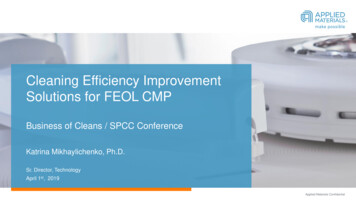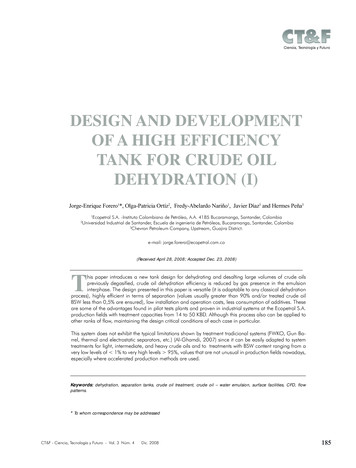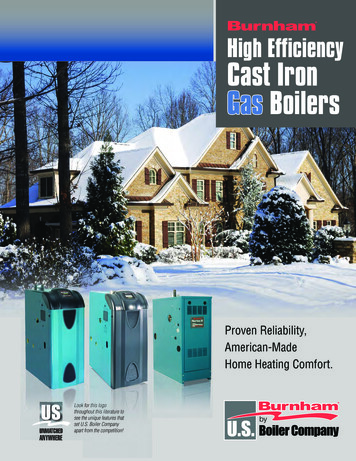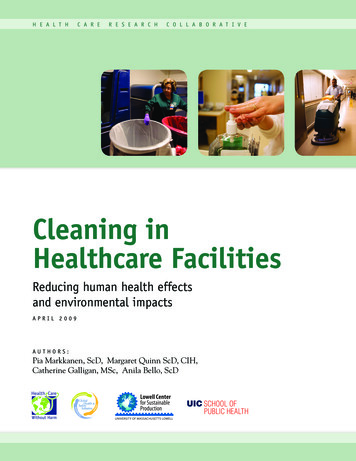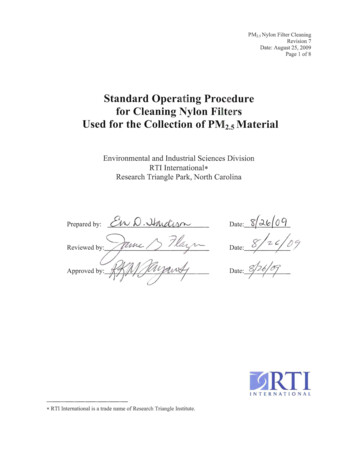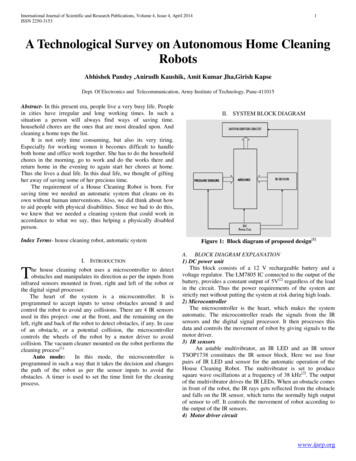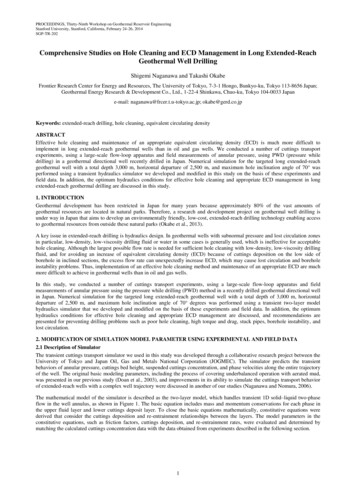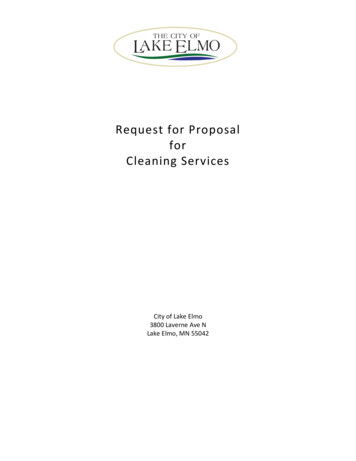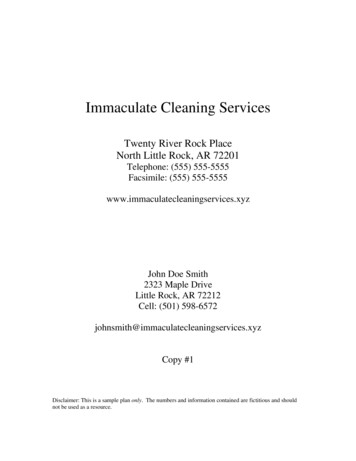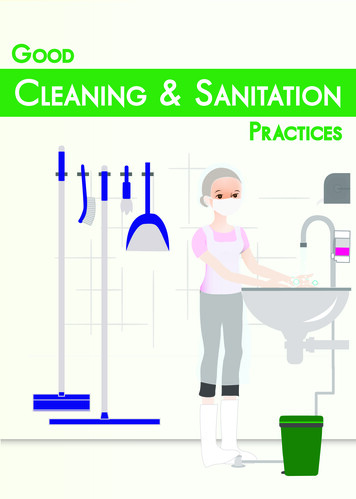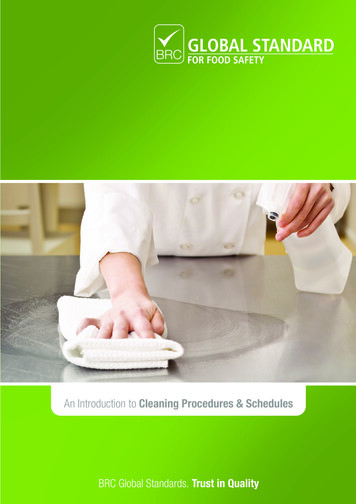
Transcription
HIGH EFFICIENCYWashers and DetergentsWorking in Harmony toSave Energy and Waterwww.cleaninginstitute.org
HE Washers and HE Detergents —Working in Harmony to Save Energy and WaterAbout This Guide:Compared to traditional washers, HE washers work in a completelydifferent way. As a result, the detergents used in HE washers need towork differently, too.That’s why the American Cleaning Institute and washingmachine experts from around the country have worked togetherto bring you this handy resource.SM You’ll discover how HE washers and HE detergents work . . . andhow to properly use these customized laundry products in yourHE washing machine. In addition, you’ll find straightforward answers to your mostfrequently asked questions about “doing your laundry the HE way.”So read on for important information that will help you use yourHE washer and HE laundry products together to save water andenergy, while getting your laundry as clean as ever!INSIDEToday’s HE Washers . . 4Today’s HE Detergents. 6Using Laundry Products in HE Washers. 8Q&A: Your HE Washer.10Q&A: Using HE Detergents.11Q&A: Maintaining Your HE Washer.13Tips for Using Dispensers.15www.cleaninginstitute.org2
BRINGING HIGH EFFICIENCYTo the Laundry RoomHE stands for highWhen high efficiency washers hit themarket a decade ago, their water andenergy savings were big news. Today,this legacy of advanced technologycontinues — but now the attention turnsto high efficiency cleaning systems!HE is important toOver the past few years, home applianceengineers and detergent scientists haveworked collaboratively to developHE washers and HE laundry detergentsthat work together. These advancementshave resulted in a harmonized cleaningsystem that gives consumers improvedcleaning performance while continuingto save water and energy.efficiency, and is usedin reference to household appliances andlaundry detergents.all of us . . . because itresults in energy andwater savings!Energy Savings At-A-Glance HE washers use less water than traditional washers — in fact, they onlyuse from 20% to 66% of the water used by traditional agitator washers. Energy use can be as little as 20 to 50 percent of the energy used bytraditional agitator washers because there’s much less water to heat. These savings translate directly to long-term cost savings for consumers— as well as significant long-term environmental benefits.HE Washers Save WaterTraditionalWasherWater LevelHE WasherWater LevelTraditional WasherFront LoadingHE Washer3Top LoadingHE Washer
TODAY’S GENERATIONOf HE WashersWhat AboutTraditional Washers?Chances are that the type ofwasher you grew up with was atop-loading “agitator” washer.It’s the tried-and-true machinethat revolutionized “doing thelaundry” many decades ago.In fact, these traditionalagitator washers are still usedtoday in most U.S. homes.In these washers, laundry iscompletely submerged inwater and an agitator movesthe laundry back and forth toloosen soils.A Growing Market:HE WashersIn recent years, sales of HE washershave grown — and today they’remaking a significant impact on thewashing machine marketplace.With current energy and waterlegislation affecting design for futurewashers, this trend is expected tocontinue into the foreseeable future.As of 2005, sales of HE washershave grown from less than 1% tomore than 15% of the market inonly 10 years.How They WorkUnlike traditional agitator washers,most HE washers use a “tumbler”system with no agitator. Becausethe new systems are designed tobe so efficient, HE washers can uselow-water wash and rinse cycles. In many models the laundry iswashed in a shallow pool of water.Traditional agitatorwashers account for 85%of washer purchases inthe U.S. as of 2005. In some models, the water level isso low you may never even see apool of water.Despite their reduced water levels,HE washers can wash the sameamount of laundry per load astraditional washers – in fact, manycan clean even larger loads.4
Types of HE WashersThere are two types of HE washers – front loading and top loading.Although each works via a different mechanical method, they bothuse considerably less water than traditional agitator washers.Environmentally-speaking, HE washers are great news!Front-loading HE WashersIn front-loading washers, the laundry tumblesback and forth through the water, as the tubrotates clockwise and then counterclockwise,moving the water and detergent through thelaundry and removing soils.This repetitive tumbling motion is intended todo an efficient cleaning and rinsing job and isgentle on fabrics.All front loading washing machinesare HE and use low-water levels inthe wash and rinse process.Top-loading HE WashersThere are a growing number of HE washersthat load from the top. These washers offergentle motion to do the laundry, usingspinning, rotating, and/or “wobbling” wheels,plates, or disks to achieve the gentle washaction. As with some front-loading HE washers,some top-loaders also spray or lightly showerclothes using re-circulated water from washand/or rinse solutions.Top-loading washers that are labeled “HE”use low-water volume wash cycles. They haveeither no center post or a smaller-sized centerpost instead of a traditional agitator.5
TODAY’S GENERATIONOf HE Laundry DetergentsThe Role of TraditionalLaundry DetergentsDetergents are star performers on laundry day. Theirprimary task is to remove soilsand stains, but they do muchmore than that. Detergentsare designed to freshen,remove odors, and brightenfabrics as they clean.Another key detergentfunction is to hold soils, andany dyes from colored fabrics,suspended in the wash water.This keeps soils and dyesfrom being re-deposited backonto the cleaned laundry.Traditional detergents areformulated to accomplishthese tasks in high watervolumes in traditionalagitator washers.Rising to the ChallengeIt’s common sense, really: because ofthe low-water wash and rinse cyclesin HE washers, HE detergents mustwork differently from traditionallaundry detergents in order to beeffective.As a result of extensive research,HE detergents are formulated to below-sudsing and quick-dispersingto get the best cleaning performancewith HE washers. Excess suds can cause problemsin HE washers by “cushioning” — oreven preventing — the tumbling action. This can impact propercleaning. HE detergents are also formulatedto hold soils and dyes in suspensionin low water volumes, so they don’tre-deposit onto cleaned laundry.TraditionalDetergent SudsingHigh-EfficiencyDetergent SudsingHE laundry detergents can beidentified by the HE symbol onthe detergent box or bottle.6
HE Detergents – The OnlyChoice for your HE WasherDetergents formulated for HE washerswork with energy-saving technology toprovide the best possible cleaning inonly 20% to 66% the amount ofwater used in traditional washers.Use HE detergents to: Get the maximum cleaning performance that HE detergents and washers candeliver. Achieve energy and water savings. Keep your HE washer in top workingcondition.For best cleaning results, alwaysread the laundry detergent label anduse the recommended amount of detergentfor your wash load size and amount of soil.Detergent AvailabilityAs HE washers become more commonplace, detergent manufacturers willcontinue working to ensure that the appropriate detergents are available.If you’ve purchased an HE washer and can’t find HE detergents: Call the toll-free number on your current detergent package, or checkthe manufacturer’s Web site to determine where or how to buy anappropriate HE detergent. Check the store where you purchased your washer. They may carryHE detergents — or know where you can purchase them.LABEL ALERT!Some detergent manufacturers label theirdetergents “HE Compatible.” Many of these detergents areregular sudsing detergents that should not be used in yourHE washer. Be sure to read detergent labels carefully!7
USING LAUNDRY PRODUCTSIn HE WashersThere is a wide variety of laundry products available today.The following guidelines will help you achieve optimumperformance from your HE washer.HE Laundry Detergents Most HE washers have detergent dispensers.Follow the washer manufacturer’s use and careguide for proper use of the detergent dispenser. If there is no dispenser, follow the washer’s useand care guide. Follow the detergent manufacturer’s instructions todetermine the correct amount of detergent to use. Do not mix powder and liquid detergents in the samedispenser compartment at the same time. Mixingpowders and liquids together may cause “caking” orclogging in the dispenser.Laundry AdditivesRinse-added Fabric Softeners Add fabric softener to the fabric softener dispenser so it gets dispensedat the right time. Follow the washer manufacturer’s use and care guidefor proper use of the dispenser. Follow the instructions on the fabric softener package to determine thecorrect amount to use. Do not use other softener dispensing agents in your HE washer, unlessyour washer’s use and care guide recommends them.Pretreats and Presoaks Pretreat and presoak products can be normal to high sudsing. Thus,their use should be limited in HE washers as they can cause oversudsing. If you experience oversudsing from pretreat or presoak products, youcan use your HE detergent as a pretreater or presoaker.8
Water Softener Additives Follow the water softener manufacturer’s recommendationsto determine the correct amount to use in your washer. Add powder or liquid water softener to the empty tubbefore adding laundry.Note: You can reduce the amount of water softener youusually use, since there is less water to soften.BleachLiquid Chlorine (Sodium Hypochlorite) Bleach Measure the bleach amount recommended in thewasher manufacturer’s use and care guide. Carefully pour the measured bleach into the bleachdispenser to avoid spills. The amount of bleach shouldnot exceed the fill line on the bleach dispenser, as this maydistribute the bleach into the wash load before desired.Color-Safe Bleach Color-safe bleach is available in liquid and powder forms. For best results,follow the washer manufacturer’s recommendations on where to put it,since different models of HE washers work differently and themanufacturer’s specific directions will help you get the best results.Check the product label to determine how much to use.Liquid Color-Safe Bleach Do not mix liquid color-safe bleach with a liquid detergent, as this candecrease the effectiveness of both products. If there is no color-safe bleach dispenser, add the liquid color-safe bleachto the empty tub before adding the laundry.Powder Color-Safe Bleach A powder color-safe bleach may be added with a powder detergent inthe detergent dispenser, if the dispenser is large enough. Do not add powder color-safe bleach with a liquid detergent. Mixingpowders and liquids together may cause “caking” in the dispenser. If there is no color-safe bleach dispenser or if the detergent dispenser isnot large enough for both powder detergent and bleach, add the powderbleach to the empty tub before adding the laundry.9
Q&A “Doing The Laundry”With Your HE WasherQ. Can I wash large loads of laundry in my HE washer?A. HE washers are often designed to wash large loads. In fact, someof these washers will effectively clean significantly larger loadsand/or bulkier loads than were possible in traditional agitatorwashers. Check your HE washing machine’s use and care guidefor specific loading capacity instructions.Q. Do I still need to sort my laundry when I use my HE washer ?A. Yes. Just as with a traditional washer, you need to sort by color,fabric type, soil levels, etc. It is especially important to sort bycolor, because there is less water in HE washers and dye transfercan be a potential problem.Q. Can I select different wash cycles on my HE washer?A. Yes. Wash cycles are comparable to those of agitator washers.Q. Will my low-water HE washer rinse as well as my previousagitator washer?A. Yes. Even though HE washers use considerably less water, theyhave two to four rinse cycles, rather than one rinse cycle as inmany agitator washers. HE detergents help assure good rinsingperformance — and in fact, multiple rinses are typically betterthan one deep rinse.Q. When I remove washed laundry from my HE washer, itsometimes seems almost dry. What setting should I use on myclothes dryer?A. The most energy-efficient way to dry your laundry is to set yourdryer on the auto-dry setting. This way the machine automaticallyshuts off when the laundry is dry.As part of their energy-saving design, most HE washers removemore water from your laundry than traditional washers do. Thus,since the load may be less wet when removed from the washer,there can be additional energy savings in the dryer, too.10
Q&A Using HE Detergents –A “Must Do” For Your HE WasherQ. Why should I use only HE detergents in my HE washer?A. HE washers are designed to save water and energy resources.To achieve these savings, HE washers are designed differentlythan traditional washers — for example, they use less water thantraditional washers.At lower water levels, cleaning problems can occur if detergentscreate too many suds or if soils from the laundry can’t be completelyrinsed out of both the laundry and the washer. Thus, detergents forHE washers need to be lower sudsing than regular detergents toprovide good cleaning and thorough rinsing.Detergent and washing machine manufacturers formulate anddesign their HE detergents and washers to work together as oneeffective cleaning system that gives you optimum cleaningperformance while saving water and energy resources.Q. What can happen if I don’t use an HE detergent in myHE washer?A. Using a regular detergent in an HE washer c
legislation affecting design for future washers, this trend is expected to continue into the foreseeable future. As of 2005, sales of HE washers have grown from less than 1% to more than 15% of the market in only 10 years. Types of HE Washers There are two types of HE washers – front loading and top loading. Although each works via a different mechanical method, they both use considerably .
